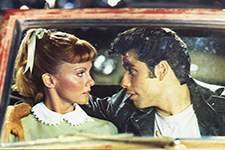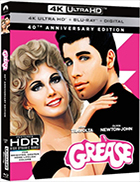Grease
|  One of my fondest memories of watching a movie in a theater was Grease—albeit not during its initial theatrical run, as I was only four years old in 1978. Instead, I had the chance ot see it on the big screen as a young adult in 1998, when it was re-released for its 20th anniversary. Not many movies get theatrical re-releases in the era of home video, but after the phenomenal success of the re-release of Star Wars in 1997, Grease was a logical flick to bring back to theaters. Not only was it an unexpectedly enormous hit back in 1978, but, like Star Wars, an entire generation (myself included) had grown up with Grease on video. And, of course, John Travolta was even hotter in post-Pulp Fiction 1998 than he was in 1978 (well, I guess that’s debatable), the public was hungry for ’70s memorabilia, and the music was still an ageless trip. Decades later, the soundtrack continues to sell well, and in 1997 the “Grease Megamix” (a souped-up re-mix of bits and pieces of all the hit songs) was one of the most requested tunes on pop stations around the country. Every time I watch Grease it feels like going to a class reunion. Seeing Travolta back in his early 20s, with a lean body and greasy black ducktail, makes it all the more amusing to remember that he was playing a gray, overweight Bill Clinton clone in Primary Colors (1998), which was screening theatrically at the same time as the Grease re-release. In both movies, Travolta radiates off the screen like a true movie star, but in Grease it’s a more primal, teen-angst kind of stardom, something along the lines of Leonardo DiCaprio in his adolescent prime. And, like DiCaprio, Travolta was not only desired for his physical attributes, but also for his talent—he rode into Grease on the critical and commercial success of Saturday Night Fever (1977), for which he was nominated for a Best Actor Oscar. When Grease was made in the late 1970s, there was a growing nostalgia for the perceived innocence and joviality of the late ’50s. As the turbulent ’70s were coming to a close, with military failure in Vietnam, the embarrassment of Watergate, racial tensions, soaring inflation, and general unpleasantness, it was nice returning to a time when black leather, fast cars, and necking in back seats were harmless means of being bad. Movies at the time were gritty, urban tales of corruption and moral ambiguity, and Grease made itself out to be the antithesis. Of course, the Eisenhower era portrayed in Grease is a time period that never really existed. It is more of a whimsical version of how we think it was—filled with shiny hot rods, black leather jackets, hip diners, clueless principals, and gangs with names like the T-Birds and the Pink Ladies. Everything is simplified down to its barest essentials, and that is what is so enjoyable about the movie. It doesn’t demand much of anything from the audience, other than they check their problems at the door and have a good time. The story about the bad greaser Danny (Travolta) and his love for the squeaky-clean new girl in town, Sandy (Olivia Newton-John), is a kind of ageless adolescent myth to which virtually anyone can relate. Based on the hit Broadway show by Jim Jacobs and Warren Case, Grease is imaginatively campy, kind of goofy, but always energetic and fun. The music, ranging from the disco-inspired title track by Frankie Valli, to the infamous “Greased Lightning” with all its automobile-inspired sexual innuendo, was hot stuff then and still is now. The songs, brought to life with lively performances choreographed by Patricia Birch (who went on to direct the ill-fated sequel, 1982’s Grease 2), have an infectious quality that always makes you want to sing along with them, no matter how cheesy (how can you not at least tap your feet to “Summer Nights” or “You’re the One That I Want”?). Probably the only let-down of Grease is how little it did for its performers. It is easy to assume that a hit like this would have been a launching pad for its twentysomething actors and actresses, but in fact almost none of them went on to meaningful film careers. Jeff Conaway, who was so good in the role of Danny’s best friend Kenickie, went nowhere. Didi Conn, who played the unforgettably giddy high-school drop-out Frenchy, didn’t even get that far (she was desperate enough to show up in Grease 2). Even Stockard Channing—whose performance as Rizzo, the tough leader of the Pink Ladies, gives Grease the closest thing it has to real drama—had a mostly uneventful screen career until she resurfaced in the early ’90s with her Oscar-nominated role in Six Degrees of Separation (1993). And what of the leads? How did Olivia Newton-John’s career take off? Does Xanadu (1980) ring a bell? And even Travolta, whose career seemed infallible at the time, made one great film (Brian De Palma’s 1981 conspiracy thriller Blow Out), one okay film (1980’s Urban Cowboy) and two really bad films (1982’s Two of a Kind, which reunited him with Olivia Newton-John, thus doubling down on their sinking careers, and 1983’s Sylvester Stallone-directed Saturday Night Fever sequel Staying Alive) before sinking into a 15-year rut from which he finally escaped with his Oscar-nominated turn in Quentin Tarantino’s generation-defining Pulp Fiction. Nevertheless, Grease was a huge success for its time because it bucked the trends and gave moviegoers something they hadn’t seen in a long time. Upbeat, funny, occasionally witty, and always enjoyable, Grease is no great piece of art, but with its complete lack of pretension, it is about as fun a movie experience as you can get.
Copyright © 2018 James Kendrick Thoughts? E-mail James Kendrick All images copyright © Paramount Home Entertainment | |||||||||||||||||||||||||||||||
Overall Rating: 

 (3)
(3)


